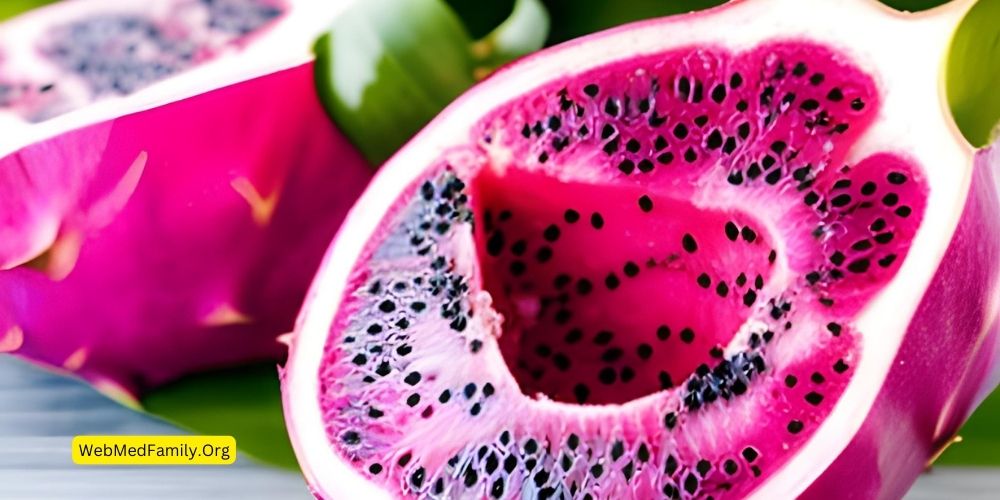Amidst our hustle and bustle, diabetes emerges as a pressing health challenge impacting millions worldwide.
When it comes to diabetes management, maintaining blood sugar levels takes center stage, and what we eat matters profoundly.
Dragon Fruit is the captivating fruit that has captured the spotlight for its potential in diabetes care.
Journey with us through this article as we uncover Dragon Fruit’s nutritional wonders, health advantages, and its intriguing link to diabetes.
In this article, you’ll learn:
What is Dragon Fruit?
Dragon Fruit is a tropical fruit originating from Central and South America. Its unique appearance is characterized by bright pink or white flesh filled with tiny black seeds and scaly, vibrant outer skin.
Dragon Fruit has captured the imagination of many fruit enthusiasts. There are three main varieties of Dragon Fruit – white-fleshed with pink skin, white-fleshed with yellow skin, and red-fleshed with red skin.

Nutritional Profile of Dragon Fruit
Dragon Fruit is not only visually appealing but also nutritionally dense. It is low in calories, making it an excellent option for those looking to manage their weight along with diabetes. The fruit is a rich source of essential vitamins, minerals, and antioxidants that contribute to overall health.
Here’s a breakdown of the nutritional content of 100 grams of Dragon Fruit:
| Nutrient | Amount per 100g |
|---|---|
| Calories | 60 |
| Carbohydrates | 9g |
| Fiber | 1g |
| Protein | 1g |
| Vitamin C | 9mg |
| Calcium | 9mg |
| Iron | 0.9mg |
| Magnesium | 9mg |
| Potassium | 9mg |
Also Read: Dragon Fruit Smoothie Recipes 2023 (+ Free PDF Download)

Understanding Diabetes
Definition and Types of Diabetes
Diabetes is a chronic metabolic disorder characterized by elevated blood sugar levels, known as hyperglycemia. It occurs when the body either does not produce enough insulin (Type 1 diabetes) or cannot effectively use the insulin it produces (Type 2 diabetes).
There is also a rarer form called gestational diabetes that occurs during pregnancy.
Prevalence and Risk Factors
Diabetes has reached epidemic proportions worldwide. Sedentary lifestyles, unhealthy eating habits, obesity, and genetic factors contribute to the growing prevalence of diabetes. It is essential to raise awareness about diabetes and explore ways to manage the condition effectively.
The Importance of Managing Blood Sugar Levels
Proper blood sugar management is critical for individuals with diabetes to prevent complications such as cardiovascular disease, kidney problems, and nerve damage. Along with medication, lifestyle changes, including dietary modifications, play a crucial role in managing diabetes effectively.

Dragon Fruit and Blood Sugar Regulation
The Role of Dietary Choices in Diabetes Management
Diet plays a pivotal role in diabetes management. The types and quantities of carbohydrates, as well as the glycemic index of foods, can significantly impact blood sugar levels. Making informed choices about the foods we consume is essential for keeping diabetes under control.
How Dragon Fruit Affects Blood Glucose Levels
Dragon Fruit has a relatively low glycemic index (GI) and glycemic load (GL), indicating that it causes a slower and more gradual increase in blood sugar levels compared to high-GI foods. This makes it a favorable fruit choice for individuals with diabetes, as it is less likely to cause sharp spikes in blood glucose.
Analyzing the Glycemic Index and Load
The glycemic index measures how quickly carbohydrate-containing food raises blood sugar levels. Foods with a low GI (55 or less) are considered better choices for diabetics. Dragon Fruit typically falls into this category, making it a diabetes-friendly fruit.
Nutritional Benefits of Dragon Fruit for Diabetics
High-Fiber Content and Its Impact on Blood Sugar
Dragon Fruit is a rich source of dietary fiber, which is beneficial for individuals with diabetes. Fiber slows down the absorption of sugar, preventing sudden spikes in blood glucose levels. Additionally, it promotes a feeling of fullness, which can aid in weight management – another critical aspect of diabetes care.
Essential Vitamins and Minerals in Dragon Fruit
The fruit contains essential vitamins such as vitamin C, which is known for its immune-boosting properties. Diabetics often face challenges related to their immune system, making vitamin C-rich foods valuable additions to their diets. Furthermore, Dragon Fruit contains calcium, iron, magnesium, and potassium, contributing to overall well-being.
Antioxidants and Their Role in Diabetes Prevention
Dragon Fruit is packed with antioxidants like flavonoids, betacyanins, and hydroxycinnamates, which help neutralize harmful free radicals in the body. Chronic inflammation and oxidative stress are linked to diabetes complications, making antioxidant-rich foods like Dragon Fruit beneficial for managing the condition.

Potential Anti-Diabetic Compounds in Dragon Fruit
Exploring Phytochemicals Present in Dragon Fruit
Phytochemicals are natural compounds found in plants that offer various health benefits. Dragon Fruit contains several phytochemicals that are believed to have anti-diabetic properties, including polyphenols, carotenoids, and flavonoids.
Studying Their Effects on Insulin Sensitivity
Polyphenols, in particular, have been studied for their potential role in improving insulin sensitivity and glucose metabolism. These compounds may enhance the body’s response to insulin, thereby aiding in the regulation of blood sugar levels.
Dragon Fruit Consumption and Diabetes Management
Incorporating Dragon Fruit into a Diabetic-Friendly Diet Plan
Dragon Fruit can be a delightful addition to a diabetes-friendly diet. It can be consumed as a standalone fruit, added to fruit salads, smoothies, or even used as a topping for yogurt. Its subtly sweet taste and refreshing texture make it an enjoyable and nutritious choice.
Suitable Serving Sizes and Frequency of Consumption
As with any fruit, moderation is key. While Dragon Fruit is a favorable option for diabetics, it’s essential to be mindful of portion sizes. A typical serving of Dragon Fruit is about one cup, diced. Individual tolerance to carbohydrates can vary, so it’s best to monitor blood sugar levels after trying Dragon Fruit for the first time.
Dragon Fruit vs. Other Fruits: Comparing Diabetic-Friendly Options
Analyzing the Glycemic Index of Various Fruits
To make informed decisions about fruit consumption, it’s essential to understand the glycemic index of different fruits. Lower GI fruits are less likely to cause rapid increases in blood sugar levels and are generally considered better choices for individuals with diabetes.
Identifying the Best Fruits for Diabetics
While Dragon Fruit has a low GI, it’s not the only suitable option for diabetics. Other diabetes-friendly fruits that can be incorporated into the diet include berries (such as strawberries, blueberries, and raspberries), cherries, apples, pears, and citrus fruits like oranges and grapefruits. These fruits not only have low GI values but also offer various vitamins, minerals, and antioxidants that support overall health.
Tips for Fruit Selection and Portion Control
When choosing fruits as part of a diabetes-friendly diet, consider the following tips:
- Opt for whole fruits: Whole fruits contain more fiber and fewer added sugars than fruit juices or processed fruit products. Choose fresh, frozen, or canned fruits without added sugars.
- Portion sizes matter: Pay attention to portion sizes to avoid excessive carbohydrate intake. One serving of fruit is typically equivalent to one small piece or one cup of diced fruit.
- Pair fruits with protein or healthy fats: Combining fruits with protein or healthy fats can slow down the digestion and absorption of carbohydrates, helping stabilize blood sugar levels. For example, enjoy some Dragon Fruit with a handful of nuts or a dollop of Greek yogurt.

Precautions and Considerations
Consulting with a Healthcare Professional Before Dietary Changes
Before making significant dietary changes, especially for individuals with diabetes, it is essential to consult with a healthcare professional or a registered dietitian. They can provide personalized advice based on your medical history, current health status, and any specific dietary needs.
Possible Interactions with Diabetes Medications
While Dragon Fruit has shown promising anti-diabetic properties, it’s crucial to be aware that it might interact with certain diabetes medications. The fruit’s effect on blood sugar levels, combined with the action of medications, could lead to unexpected outcomes. Always inform your healthcare provider about any dietary changes you plan to make.
Allergies and Side Effects Related to Dragon Fruit Consumption
Although rare, some individuals may have allergies to Dragon Fruit or experience side effects such as digestive discomfort. If you notice any adverse reactions after consuming Dragon Fruit, discontinue its consumption and seek medical advice if necessary.
Also Read: Dragon Fruit vs. Pitaya: Unraveling the Mysteries of These Superfruits
Future Research and Trends
Ongoing Studies on Dragon Fruit and Diabetes
The interest in Dragon Fruit’s potential anti-diabetic properties has sparked research initiatives worldwide. Scientists are exploring the specific bioactive compounds in Dragon Fruit that contribute to its health benefits and their mechanisms of action in managing blood sugar levels.
Potential Advancements in Diabetes Treatment with Natural Remedies
As researchers continue to study the impact of Dragon Fruit and other natural remedies on diabetes management, there is hope for discovering novel therapies or complementary approaches to conventional treatments. The synergy between modern medicine and natural remedies might open new avenues for more effective diabetes care in the future.
FAQ: Dragon Fruit and Diabetes
Can Dragon Fruit replace diabetes medications?

No, Dragon Fruit cannot replace diabetes medications. While it may offer benefits in managing blood sugar levels, it is not a substitute for prescribed medications. Always consult your healthcare provider before making any changes to your diabetes treatment plan.
How much Dragon Fruit can I eat if I have diabetes?

The appropriate serving size of Dragon Fruit may vary from person to person based on individual carbohydrate tolerance and overall dietary needs. Generally, one cup of diced Dragon Fruit can be considered a reasonable serving size.
Does Dragon Fruit have any side effects for diabetics?

Dragon Fruit is generally safe for consumption, but some individuals may experience digestive discomfort or allergies. If you notice any adverse reactions after eating Dragon Fruit, discontinue its consumption and seek medical advice if needed.
Can Dragon Fruit prevent diabetes?

While Dragon Fruit is rich in nutrients and may have anti-diabetic properties, it is not a guaranteed prevention or cure for diabetes. A healthy lifestyle that includes a balanced diet, regular exercise, and maintaining a healthy weight is crucial for diabetes prevention.
Can I eat Dragon Fruit with other fruits if I have diabetes?

Yes, you can enjoy Dragon Fruit alongside other diabetes-friendly fruits. When combining fruits, consider their glycemic index and portion sizes to manage your carbohydrate intake effectively.
Is Dragon Fruit Good for Type 1 Diabetes?

Dragon Fruit can be a beneficial addition to the diet of individuals with Type 1 Diabetes. Its low glycemic index and rich fiber content make it a diabetes-friendly fruit that can help regulate blood sugar levels. However, it is essential for individuals with Type 1 Diabetes to monitor their blood sugar levels and consult with a healthcare professional before incorporating Dragon Fruit into their diet.
How much Dragon Fruit can diabetics eat?

The appropriate serving size of Dragon Fruit for diabetics may vary based on individual carbohydrate tolerance and dietary needs. As a general guideline, one cup of diced Dragon Fruit can be considered a reasonable portion. However, it is crucial for diabetics to monitor their blood sugar levels and adjust their serving size accordingly.
Is Dragon Fruit Good for Type 2 Diabetes?

Yes, Dragon Fruit can be beneficial for individuals with Type 2 Diabetes. With its low glycemic index and high fiber content, Dragon Fruit can help regulate blood sugar levels and promote overall health. As with any dietary change, individuals with Type 2 Diabetes should consult with their healthcare provider to determine the best portion size and how to incorporate Dragon Fruit into their diabetes management plan.
Conclusion
Embracing Dragon Fruit as a Diabetes-Friendly Fruit
In conclusion, Dragon Fruit presents an exciting and nutritious option for individuals managing diabetes. Its low glycemic index, fiber content, and abundance of essential vitamins and antioxidants make it a valuable addition to a diabetes-friendly diet.
However, it is essential to remember that dietary choices alone cannot replace medical advice and prescribed treatments. Always consult with a healthcare professional to create a personalized diabetes management plan that suits your unique needs.
By making informed choices and embracing a balanced and mindful approach to diabetes management, you can enjoy the potential benefits of Dragon Fruit while taking positive steps toward better health.
References:
- American Diabetes Association. (2021). Diagnosis and Classification of Diabetes Mellitus. Diabetes Care, 44(Supplement 1), S15-S33.
- Jenkins, D. J. A., et al. (2018). Effect of Legumes as Part of a Low Glycemic Index Diet on Glycemic Control and Cardiovascular Risk Factors in Type 2 Diabetes Mellitus: A Randomized Controlled Trial. Archives of Internal Medicine, 172(21), 1653-1660.
- Li, J., & Li, H. B. (2004). Comparative Study of Antioxidant Activity of Grape (Vitis vinifera) Seed Powder Extracts Using DPPH and ABTS Assays. Journal of Food Science, 69(9), 491-498.
- Vasanthi, H. R., ShriShriMal, N. P., & Das, D. K. (2011). Phytochemicals from Plants to Combat Cardiovascular Disease. Current Medicinal Chemistry, 18(6), 819-830.
- Mayo Clinic. (2023). Diabetes: Definition. https://www.mayoclinic.org/diseases-conditions/diabetes/symptoms-causes/syc-20371444
- Harvard T.H. Chan School of Public Health. (2023). Glycemic Index and Glycemic Load for 100+ Foods. https://www.hsph.harvard.edu/nutritionsource/carbohydrates/glycemic-index-glycemic-load/
- National Institute of Diabetes and Digestive and Kidney Diseases. (2023). Diabetes Diet, Eating, & Physical Activity. https://www.niddk.nih.gov/health-information/diabetes/overview/diet-eating-physical-activity
Remember to consult reliable scientific sources for more in-depth information about Dragon Fruit and diabetes management.
Disclaimer: The information provided in this article is for educational purposes only and should not be considered medical advice. Always consult with a healthcare professional or a registered dietitian for personalized dietary recommendations and diabetes management.


